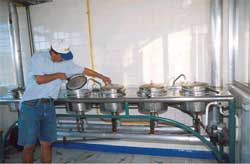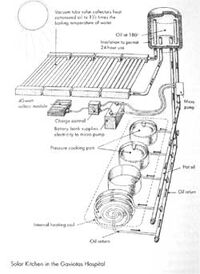Tom Sponheim (talk | contribs) mNo edit summary |
Tom Sponheim (talk | contribs) mNo edit summary |
||
| (2 intermediate revisions by the same user not shown) | |||
| Line 1: | Line 1: | ||
{{GoogleTranslateLinks}} |
{{GoogleTranslateLinks}} |
||
| + | {{ArchivedPage}} |
||
{{Updated|7|7|09}} |
{{Updated|7|7|09}} |
||
[[File:Gaviotas1.jpg|right]] |
[[File:Gaviotas1.jpg|right]] |
||
[[File:Gaviotas2.jpg|right|200px]] |
[[File:Gaviotas2.jpg|right|200px]] |
||
Gaviotas is a 200-person sustainable living community based in [[Colombia]]. In the hospital, a [[Institutional|community solar cooker]] has been installed. It consists in an exterior hole tube solar collector, located in the building's roof, where cotton seed oil is heated. In sunny days, the oil may reach 180 ºC. In the storage tank, the difference in temperature creates a natural circulation: hot oil is sucked in the tank while colder oil, lower in the tank, goes into the collector to be heated. The tank includes two more holes (a superior inlet and an inferior outlet) to allow for oil transportation to the building. To take the heated oil to the interior of the building, a little 40 w pump (solar powered by the photovoltaic collectors and battery system) is used. The oil passes through 6 coils that surround the stainless steel pressure cookers where cooking takes place. Then, cool oil comes back to the storage tank. Both the tank and the pipes are thermically insulated. The oil is kept hot so it is possible to cook at night or in bad weather conditions (clouds, rain). |
Gaviotas is a 200-person sustainable living community based in [[Colombia]]. In the hospital, a [[Institutional|community solar cooker]] has been installed. It consists in an exterior hole tube solar collector, located in the building's roof, where cotton seed oil is heated. In sunny days, the oil may reach 180 ºC. In the storage tank, the difference in temperature creates a natural circulation: hot oil is sucked in the tank while colder oil, lower in the tank, goes into the collector to be heated. The tank includes two more holes (a superior inlet and an inferior outlet) to allow for oil transportation to the building. To take the heated oil to the interior of the building, a little 40 w pump (solar powered by the photovoltaic collectors and battery system) is used. The oil passes through 6 coils that surround the stainless steel pressure cookers where cooking takes place. Then, cool oil comes back to the storage tank. Both the tank and the pipes are thermically insulated. The oil is kept hot so it is possible to cook at night or in bad weather conditions (clouds, rain). |
||
| + | |||
| + | ==News and recent developments== |
||
| + | *'''January 2009:''' Gaviotas features a community dining hall that is very popular with the villagers. Its kitchen makes about 200 meals a day. The massive cooking stoves have now been equipped with internal piping through which water is heated to near boiling and is then circulated without a pump, simply via natural convection (thermosiphon). This new heat exchange system replaces the 30 solar collectors that used to sit on the roof of the dining hall. The old collectors (also thermosiphon with no moving parts) are still in top shape, so they will simply get a new paint job and be sold for $1,000 a piece![http://www.friendsofgaviotas.org/events--updates.html] |
||
==See also== |
==See also== |
||
| Line 14: | Line 18: | ||
[[Category:Solar cooker designs]] |
[[Category:Solar cooker designs]] |
||
[[Category:Colombia]] |
[[Category:Colombia]] |
||
| − | [[Category:Solar restaurants and bakeries]] |
||
Revision as of 06:57, 29 November 2014
|
Last edited: 7 July 2009
|
Gaviotas is a 200-person sustainable living community based in Colombia. In the hospital, a community solar cooker has been installed. It consists in an exterior hole tube solar collector, located in the building's roof, where cotton seed oil is heated. In sunny days, the oil may reach 180 ºC. In the storage tank, the difference in temperature creates a natural circulation: hot oil is sucked in the tank while colder oil, lower in the tank, goes into the collector to be heated. The tank includes two more holes (a superior inlet and an inferior outlet) to allow for oil transportation to the building. To take the heated oil to the interior of the building, a little 40 w pump (solar powered by the photovoltaic collectors and battery system) is used. The oil passes through 6 coils that surround the stainless steel pressure cookers where cooking takes place. Then, cool oil comes back to the storage tank. Both the tank and the pipes are thermically insulated. The oil is kept hot so it is possible to cook at night or in bad weather conditions (clouds, rain).
News and recent developments
- January 2009: Gaviotas features a community dining hall that is very popular with the villagers. Its kitchen makes about 200 meals a day. The massive cooking stoves have now been equipped with internal piping through which water is heated to near boiling and is then circulated without a pump, simply via natural convection (thermosiphon). This new heat exchange system replaces the 30 solar collectors that used to sit on the roof of the dining hall. The old collectors (also thermosiphon with no moving parts) are still in top shape, so they will simply get a new paint job and be sold for $1,000 a piece![1]


